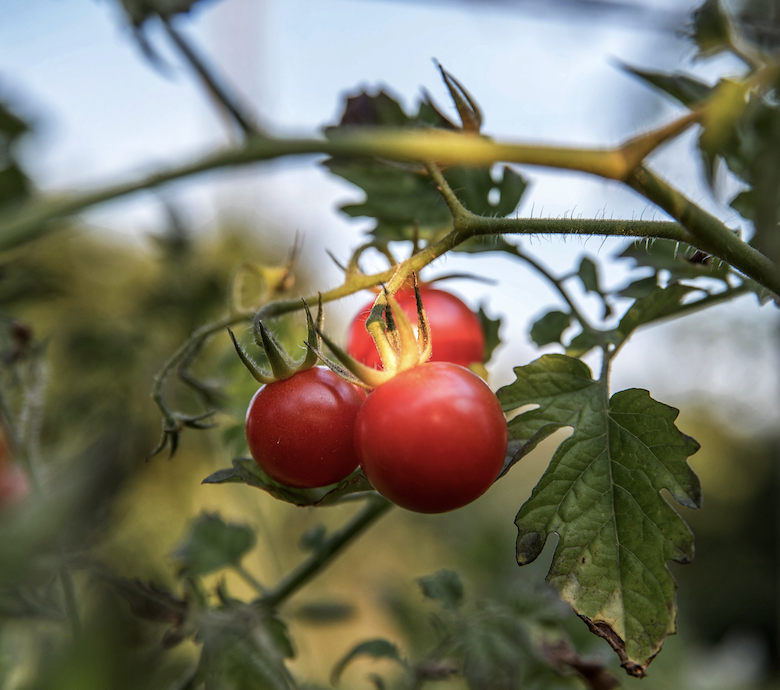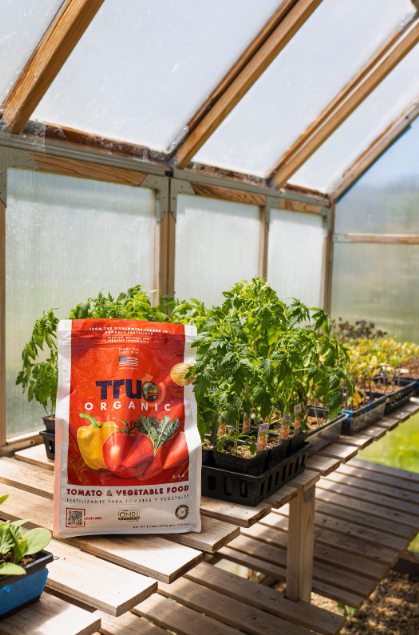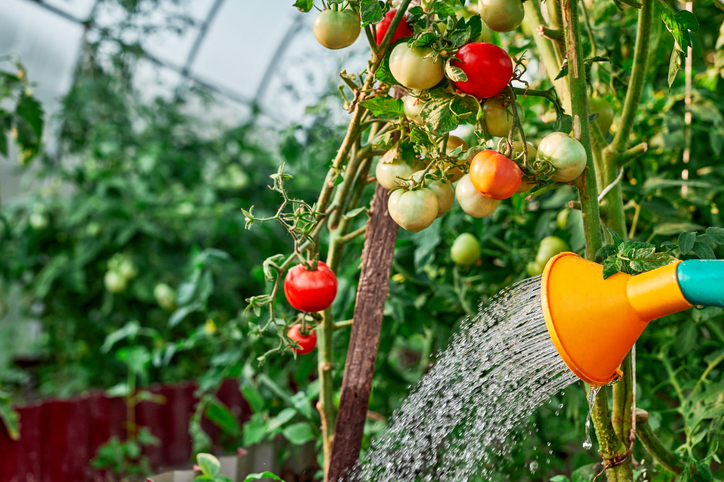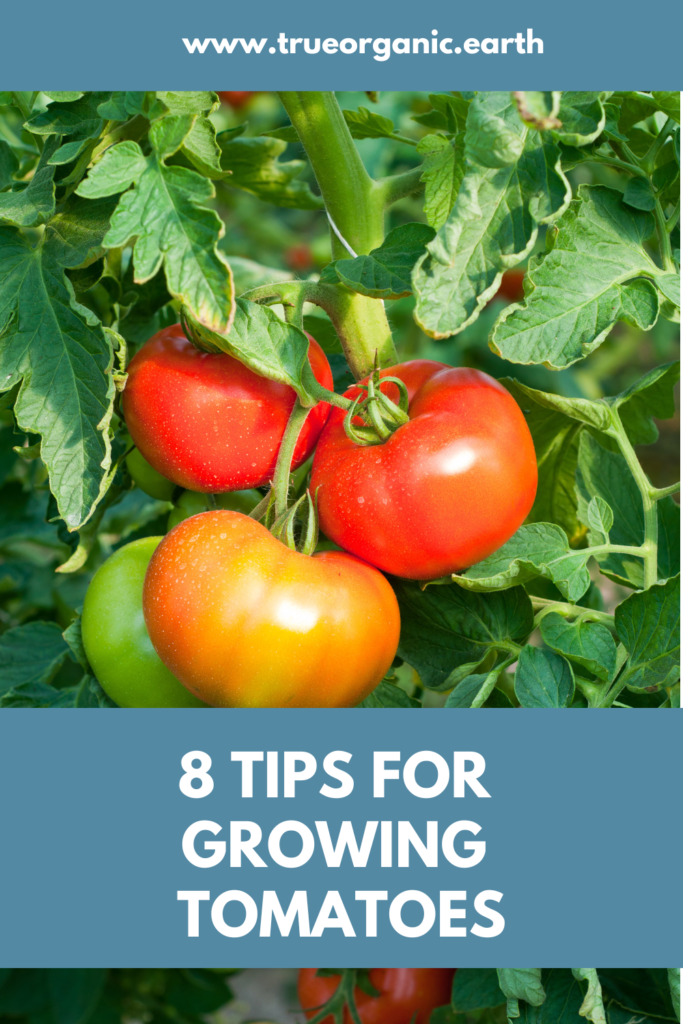May 21, 2023
8 Tips for Growing Perfect Organic Tomatoes at Home
8 Tips for Growing Perfect Organic Tomatoes at Home
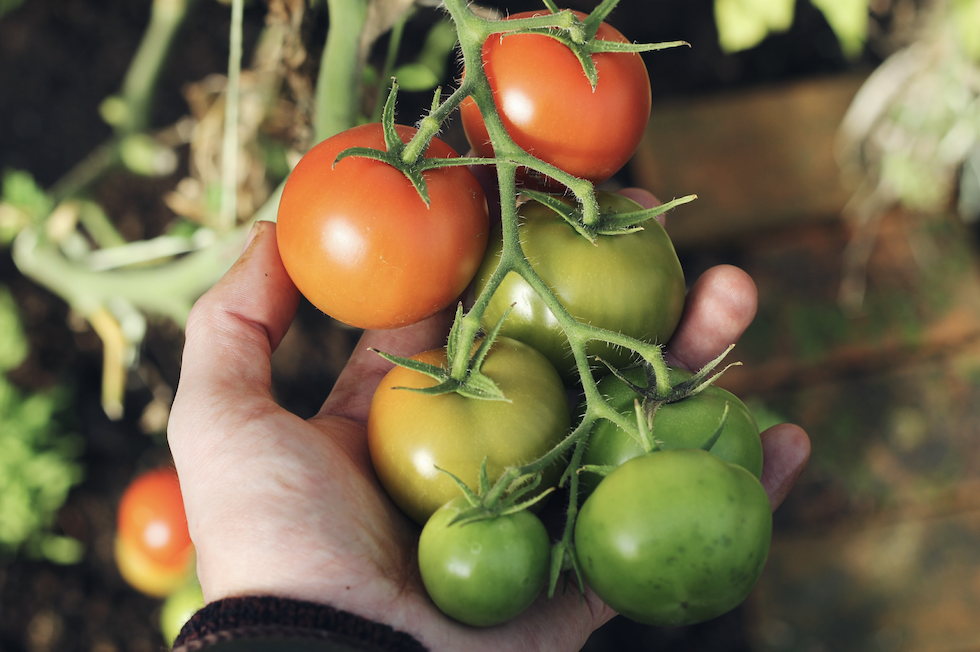
Let’s take a look at the basics of growing organic tomatoes at home to get you set up for success.
 #1: Sun, sun, sun!
#1: Sun, sun, sun!
What you’ve heard is true: tomatoes need lots of sun! At least 6 hours or more of direct sunlight daily is ideal. Any less and your plants won’t produce the harvest you want.
#2: Choose your variety: Determinate or Indeterminate?
Determinate tomato varieties are more short-living plants, will stop growing at a certain size or height, and tend to ripen all their fruit around the same time — making them perfect for canning, freezing, big-batch cooking, and giving away.
Indeterminate tomatoes keep growing into the Fall in many Zones (even until the first frost) and their fruits need longer to ripen. Mostly heirloom varieties, indeterminate tomatoes are the kind that can reach towering heights and will provide you with juicy tomatoes for months. Since they grow so much, it’s a good idea to prune these types of tomato plants for size, yield, and to be sure they don’t take over the garden (unless you have room for that!).
There are also a few varieties in the middle: semi-determinate or dwarf tomato plants aren’t quite one or the other — they are usually on the smaller size, making them great for container gardens, but grow like indeterminate varieties, so it’s a good idea to stake and prune them.
Choose a variety (or a few!) of tomatoes that works best for your planting site and harvest desires.
#3: To prevent common diseases, think before you plant.
Tomatoes can thrive in-ground, in large containers, or in raised beds. What’s best for your specific tomato garden will depend not only on your variety of choice (see above) but also the soil makeup in your garden or yard, your USDA Plant Hardiness Zone, having access to a watering source (since tomatoes need regular watering), and well-draining soil.
Curious about container gardening? Check out our Container Gardening 101 blog to get started on your own small-space garden.
Here are a few essentials pointers for choosing a good site for growing healthy tomatoes:
- Remember that an all-around healthy plant is less likely to be the victim of any disease, so start with attentive nurturance for your tomatoes.
- Ensure good soil drainage. Without properly draining soil, tomatoes are very susceptible to fungal diseases and pests that can wreck your whole crop.
- Depending on your soil content and structure,
- Choose a site with good air circulation. This is a very important factor to help prevent catastrophic tomato disease like blight and fatal fungal diseases.
- Always plant, dig, and prune with cleaned tools to prevent the spread of disease.
#4: Give your tomatoes an organic nutrient boost.
We formulated True Organic Tomatoes & Vegetable Food to give tomatoes and other heavy-feeding plants exactly what they need.
Add organic fertilizer to your soil before planting, according to package instructions, to support new plants. Throughout the season, you can fertilize with our granular formula monthly, depending on your planting site (container tomatoes need less frequent feeding), plant size, and other factors that are impacting your plants.
#5: Support your growing tomatoes.
Staking, caging, and trellising tomato plants is important for all indeterminate tomatoes and even some determinate plants. Create a support structure for your tomatoes right away when you plant them — when they are young, healthy, and adaptable.
As they grow, encourage them to use their support structure, and they’ll grow even more robustly!
#6: The secret to watering tomatoes.
It’s a subject of frequent conversation in the gardening world: How much water do tomatoes really need?
The secret is…well, there really is no secret. Sorry! But in general, tomato plants need about one inch of water per square foot per week. They require consistent watering and you should never let their soil dry out — that can lead to weakness, making them targets for pests and diseases.
It’s best to water in the morning and/or evening and to avoid getting water on the tomato leaves during hot sunny days. During the hottest days of summer, you may need to water two times a day. This is especially true for container-housed tomatoes, since the smaller volume of soil can’t hold as much moisture.
Companion planting can benefit tomatoes not only as a natural pest prevention method (read on for more on that) but also to prevent weeds, aerate soil, and in general support soil health and structure — all things that can make sure soil is well-draining. For companion planting with tomatoes, try: calendula, sage, marigolds, nasturtium, parsley and cilantro, sweet alyssum, and garlic.
#7: Organic pest prevention.
Hornworms, spider mites, aphids, and whiteflies are only a few of the pests that can destroy your tomato harvest. Unlike the ecosystem’s beneficial insects, these little bugs can transmit plant diseases, chew holes in your tomato leaves and fruits, and suck the life out of your precious garden.
To encourage a healthy, biodiverse garden ecosystem, there are a few awesome ways to keep pests away organically.
- Pinch-off: It’s tedious, but for the bigger, non-winged pests like hornworms, you can simply pick off the pests with your fingers.
- Companion planting: Growing pollinator plants near your tomatoes can attract other insects (and birds) that eat those pesky insects.
- Non-toxic pest-blockers like diatomaceous earth can work well against crawling bugs.
#8: Preventing blossom-end rot
We’ve gone over how to protect tomatoes from fungus and pests, but what about the most dreaded harvest-spoiling ailment of them all: blossom-end rot?
Blossom-end rot (BER) starts as a dark, soggy area at the “blossom end” of the fruit and can cause the entire tomato to become a yucky brown lump. It can seemingly arise suddenly in otherwise healthy tomatoes and can be incredibly frustrating!
Learn more about blossom-end rot in other vegetables.
As our R&D Team member Andrew Pedersen shares in this short video, blossom-end rot is a result of calcium deficiency when the fruit was young and can be prevented by making sure you’re watering your plants properly. It can show up when tomatoes are under-watered, over-watered or watered inconsistently, or when there’s an excess of nitrogen or other calcium-blocking minerals in your soil.
Be sure to not over-fertilize as an attempt to cure blossom-end rot! Check out Andrew’s video for a few more tips about the nutrient makeup and plant structure that can help your tomatoes avoid succumbing to BER.
Happy growing!
Show us your True Organic Plants
#GrowWithTrue
www.trueorganic.earth

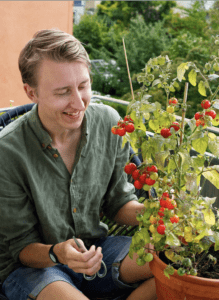 #1: Sun, sun, sun!
#1: Sun, sun, sun! 